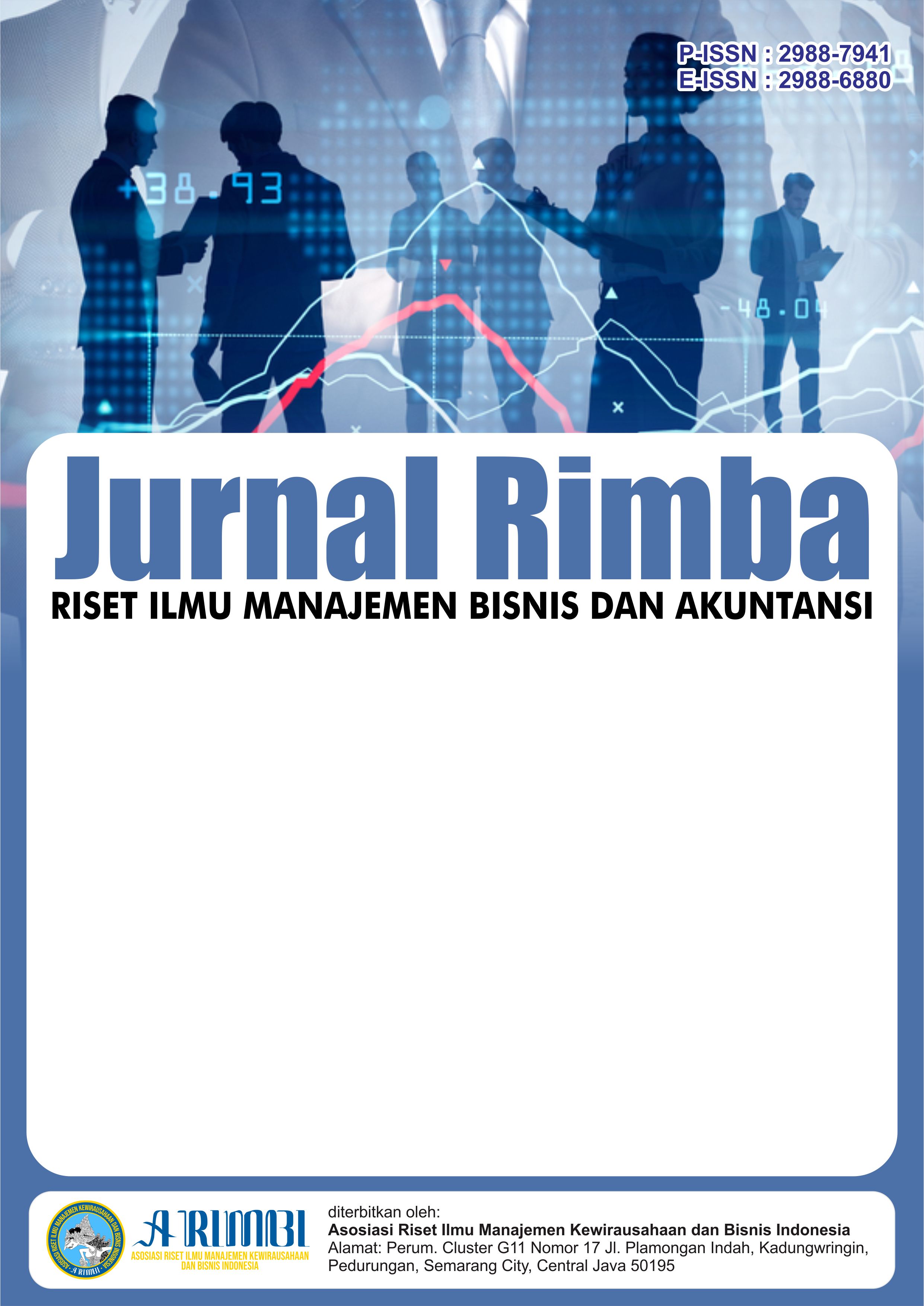Analisis Pengaruh Model Utaut 2, Trust, dan Perceived Risk Terhadap Behavioral Intention pada Aplikasi Byond By BSI
DOI:
https://doi.org/10.61132/rimba.v3i3.2060Keywords:
Trust, Behavioral Intention, Perceived Risk, UTAUT 2Abstract
This study aims to identify the factors that influence the interest of Bank Syariah Indonesia (BSI) customers in using the Byond by BSI application, using the Unified Theory of Acceptance and Use of Technology 2 (UTAUT 2) approach. This application is one of the digital innovations developed by BSI to improve digital banking services. The data in this study were obtained from primary data collected directly through a Google Form questionnaire distributed to 290 respondents who are BSI customers and users of the Byond by BSI application. The study employed a non-probability sampling method with purposive sampling technique, where respondents were selected based on specific criteria relevant to the research objectives. Data analysis was conducted through several stages, including descriptive statistics, validity and reliability tests, normality tests, multicollinearity, heteroskedasticity, as well as multiple linear regression analysis and hypothesis testing. Data processing was conducted using SPSS software version 30. The results of the analysis indicate that all variables studied, performance expectancy, effort expectancy, facilitating conditions, hedonic motivation, habit, trust, and perceived risk have a positive and significant influence on behavioral intention or users' interest in continuing to use the Byond by BSI app.
Downloads
References
Achiriani, M. P. A., & Hasbi, I. (2021). Pengaruh Performance Expectancy, Effort Expectancy, Social Influence, Perceived Risk, Perceived Cost Terhadap Behavioral Intention Pada Pengguna Dompet Digital Dana di Indonesia. E-Proceeding of Management, 8(1), 376–388.
Achmadi, C. R., Nurrahman, A., Saputri, A., & Nugraha, R. A. Z. (2024). Peran Brand Trust, Facilitating Condition, Dan Behavioral Intention Terhadap Minat Investasi Pada Mobile Banking. Jurnal Manajemen Bisnis Era Digital (JUMABEDI), 1(2), 108–119. https://doi.org/10.61132/jumabedi.v1i2.75
Afandi, A., Fadhillah, A., & Sari, D. P. (2021). Pengaruh Persepsi Kegunaan, Persepsi Kemudahan dan Persepsi Kepercayaan Terhadap Niat Menggunakan E-Wallet Dengan Sikap Sebagai Variabel Intervening. Journal of Social Science Research, 1(2), 568–577. https://doi.org/https://doi.org/10.31004/innovative.v1i2.3123
Afif, N., Purwantini, A. H., & Muhdiyanto. (2023). The Paradox of Perceived Risk and Trust on Intention to Use Fintech Payment: Evidence in MSMEs. Proceedings of the 3rd Borobudur International Symposium on Humanities and Social Science 2021 (BIS-HSS 2021), 645–648. https://doi.org/10.2991/978-2-494069-49-7_106
Ambarawati, R., Harja, Y. D., & Thamrin, S. (2020). The Role of Facilitating Conditions and User Habits: A Case of Indonesian Online Learning Platform. Journal of Asian Finance, Economics and Business, 7(10), 481–489. https://doi.org/10.13106/jafeb.2020.vol7.no10.481
Audina, M., Isnurhadi, & Andriana, I. (2021). Faktor yang Mempengaruhi Behavioral Intention Transaksi Keuangan Digital (E-Wallet) pada Generasi Milenial di Kota Palembang. Media Riset Bisnis & Manajemen, 21(2), 99–116.
Aviyanti, R. D., Saraswati, E., & Prastiwi, A. (2021). Analysis of Acceptance of Accounting Information System Implementation Based on Electronic Payment Using the Utaut Model. The International Journal of Accounting and Business Society, 29(2), 119–149. https://doi.org/10.21776/ub.ijabs.2021.29.2.8
Bashir, N. A. A. (2020). Penerapan Model UTAUT 2 Untuk Mengetahui Faktor-Faktor Yang Memengaruhi Penggunaan SIORTU. Elinvo (Electronics, Informatics, and Vocational Education), 5(1), 42–51. https://doi.org/10.21831/elinvo.v5i1.30636
Desvira, N. S., & Aransyah, M. F. (2023). Analysis of Factors Influencing Interest and Behavior in Using ShopeePay Features Using the Unified Theory of Acceptance and Use of Technology (UTAUT2) Model. Jurnal Sisfokom (Sistem Informasi Dan Komputer), 12(2), 178–191. https://doi.org/10.32736/sisfokom.v12i2.1594
Devi, N. M. S. R., Ardani, W., & Putri, I. A. S. (2022). Presidensi Indonesia G20 dan Pengaruhnya terhadap Trust dan Behavioral Intentions Wisatawan ke Destinasi Wisata di Bali (Studi Kasus pada Desa Wisata Penglipuran). Lensa Ilmiah: Jurnal Manajemen Dan Sumberdaya, 1(1), 1–6. https://doi.org/10.54371/jms.v1i1.165
Djimesha, E. S., & Suryani, E. (2024). Analysis of Factors Affecting Intention in Using Google Classroom in Post-Pandemic Era with UTAUT2 Approach. CogITo Smart Journal, 10(1), 566–577. https://doi.org/10.31154/cogito.v10i1.666.566-577
Dwi, H. K. (2024, November 10). BSI Kini Punya Super App Byond, Ini 5 Perbedaannya dengan BSI Mobile. Kontan.Co.Id. https://keuangan.kontan.co.id/news/bsi-kini-punya-super-app-byond-ini-5-perbedaannya-dengan-bsi-mobile
Fitria, N., Nurdin, R., & Amri, K. (2020). Perilaku Muzakki Menggunakan Layanan M-Banking dengan Behavior Intention Sebagai Variabel Intervening. Jurnal Ekonomi Manajemen Dan Sekretari, 9(2), 72–82. https://doi.org/https://doi.org/10.35870/jemensri.v9i2.2978
Foroughi, B., Senali, M. G., Iranmanesh, M., Khanfar, A., Ghobakhloo, M., Annamalai, N., & Naghmeh-Abbaspour, B. (2024). Determinants of Intention to Use ChatGPT for Educational Purposes: Findings from PLS-SEM and fsQCA. International Journal of Human-Computer Interaction, 40(17), 4501–4520. https://doi.org/10.1080/10447318.2023.2226495
Ghozali, I. (2018). Aplikasi Analisis Multivariate dengan Program IBM SPSS 25. Badan Penerbit Universitas Diponegoro, Semarang.
Ha, M. T., Tran, K. T., Sakka, G., & Ahmed, Z. U. (2024). Understanding perceived risk factors toward mobile payment usage by employing extended technology continuance theory: a Vietnamese consumers’ perspective. Journal of Asia Business Studies, 18(1), 158–182. https://doi.org/10.1108/JABS-01-2023-0025
Hair, J. F., Hult, G. T. M., Ringle, C., & Sarstedt, M. (2022). A Primer on Partial Least Squares Structural Equation Modeling (PLS-SEM). Sage Publishing.
Hasanah, N., Putra, S. S., & Digdowiseiso, K. (2023). Pengaruh Service Quality, Trust dan Customer Satisfaction Terhadap Behavioural Intention Nasabah Tabungan BTN Batara pada Bank BTN KC Depok. Management Studies and Entrepreneurship Journal (MSEJ), 4(6), 8927–8934. https://doi.org/https://doi.org/10.37385/msej.v4i6.3672
Hidayat, M. T., Aini, Q., & Fetrina, E. (2020). Penerimaan Pengguna E-Wallet Menggunakan UTAUT 2 (Studi Kasus). Jurnal Nasional Teknik Elektro Dan Teknologi Informasi, 9(3), 239–247. https://doi.org/10.22146/.v9i3.227
Hidayatullah, S., Ardianto, Y. T., H, A. O., Rachmawati, I. K., & Alvianna, S. (2020). Performance Expectancy, Effort Expectancy, Social Influence on Behavioral To Use Through Behavioral Intention in Using Mobile Banking in Malang. International Conference of Graduate School on Sustainability, December, 272–276.
Hutabarat, Z., Suryawan, I. N., Andrew, R., Padua, F., & Akwila. (2021). Effect Of Performance Expectancy And Social Influence On Continuance Intention In OVO. Jurnal Manajemen, 25(1), 125. https://doi.org/10.24912/jm.v25i1.707
Judijanto, L., Anggraini, F. D., Supartha, I. K. D., Irmadiani, N. D., Mudjiyant, R., & Putri, A. (2024). Bisnis Digital : Tren dan Perkembangannya Saat Ini (E. Rianty & I. Uzma (eds.)). PT. Green Pustaka Indonesia.
Martini, K. B., Widiastuti, P., Novarentika, P., & Putri, S. (2023). Pengaruh E-Service Quality , E-Trust , dan Image Bisnis Terhadap E-Loyalty Pelanggan Toko. Jurnal Majalah Ilmiah Widyacakra, 6(2), 30–43.
Miraza, Z., Setiamy, A. A., & Syahputra, T. A. (2022). Customer Value dan Technology Acceptance sebagai Faktor Penentu Behavior Intention Melalui Trust dan Customer Value Pengguna Aplikasi Gerak Virtual Race. Jurnal Administrasi Bisnis, 11(1), 65–74. https://doi.org/10.14710/jab.v11i1.41975
Muhammad, I. N., Hariyono, H., & Wardani, R. (2023). Analisis Persepsi Penggunaan Sistem Registrasi Online pada Pasien Rawat Jalan RSUD Kota Madiun dengan Pendekatan UTAUT. Jurnal Manajemen Kesehatan Yayasan RS.Dr. Soetomo, 9(1), 114. https://doi.org/10.29241/jmk.v9i1.1398
Musahidah, U., & Sobari, N. (2021). Determinants of the Intentions of Indonesian Muslim Millennials in Cash Waqf Using E-Payment. Jurnal Ekonomi Dan Perbankan Syariah, 9(2), 65–91. https://doi.org/10.46899/jeps.v9i2.284
Ningsih, A., & Hamid, R. S. (2022). Peran Effort Expectancy Facilitating Conditions Price Value dalam Menentukan Behavioural Intentions Pada Nasabah Pengguna Mobile Banking. Owner: Riset & Jurnal Akuntansi, 7(1), 322–332. https://doi.org/10.33395/owner.v7i1.1263
Pakaya, N., & Ladiku, R. (2024). Mengukur Penerimaan Aplikasi Transportasi Online Menggunakan Model UTAUT 2. Jambura Journal of Informatics, 6(1), 64–74. https://doi.org/10.37905/jji.v6i1.24735
Pangestu, M. G. (2022). Behavior Intention Penggunaan Digital Payment QRIS Berdasarkan Model Unified Theory of Acceptance and Use of Technology (UTAUT) (Studi pada UMKM Sektor Industri Makanan & Minuman di Kota Jambi). Jurnal Ilmiah Manajemen Dan Kewirausahaan (JUMANAGE), 1(1), 29–37. https://doi.org/10.33998/jumanage.2022.1.1.23
Pasaribu, P. N. (2021). The Nexus of Covid-19 Pandemic and Behavioral Intention in Using Mobile Banking among Students. Duconomics Sci-Meet (Education & Economics Science Meet), 1, 402–413. https://doi.org/10.37010/duconomics.v1.5487
Porie, C. D. E., & Dewiyana, H. (2022). Analisis Penerapan Model UTAUT 2 (Unified Theory of Acceptance and Use of Technology 2) pada Aplikasi USULib Mobile. Of Chemical EducationJournal, 2(December), 0–10.
Pramudita, E., Achmadi, H., & Nurhaida, H. (2023). Determinants of behavioral intention toward telemedicine services among Indonesian Gen-Z and Millenials: a PLS–SEM study on Alodokter application. Journal of Innovation and Entrepreneurship, 12(1). https://doi.org/10.1186/s13731-023-00336-6
Prasetyo, A., & Wardhani, A. M. N. (2022). Analisis Pengaruh Perceived Risk dan Trust terhadap Pengujian Behavioral Intention Mahasiswa Pengguna GoPay. EXERO : Journal of Research in Business and Economics, 5(1), 36–63. https://doi.org/10.24071/exero.v5i1.5038
Ramadya, I. R. (2022). Pengaruh Perceived Ease of Use Dan Perceived Usefulness Terhadap Attitude Toward Using Serta Dampaknya Terhadap Behavioral Intention. Jurnal Manajemen Pemasaran Dan Perilaku Konsumen, 1(4), 553–561. https://doi.org/10.21776/jmppk.2022.01.4.14
Raza, S. A., Qazi, W., Khan, K. A., & Salam, J. (2021). Social Isolation and Acceptance of the Learning Management System (LMS) in the time of COVID-19 Pandemic: An Expansion of the UTAUT Model. Journal of Educational Computing Research, 59(2), 183–208. https://doi.org/10.1177/0735633120960421
Riza, A. F. (2021). The potential of digital banking to handle the Covid-19 pandemic crisis: Modification of UTAUT model for Islamic finance industry. Jurnal Ekonomi & Keuangan Islam, 7(1), 1–16. https://doi.org/10.20885/jeki.vol7.iss1.art1
Rwezaula, A., Mwageni, T., & Tonya, E. (2022). The Influence of Expectations Regarding Performance on the Acceptance of Mobile Phone Banking Services by Smallholder Farmers:A Case of Smallholder Grape Farmers in Dodoma Region, Tanzania. Rural Planning Journal, 16(1), 1–23.
Sani, H., Abdulhamid, U. N., & Salisu, M. (2024). Impacts of Hedonic Motivation and Social Influence in Self-Broadcasting Using Social Media Platforms. International Journal of Computer Applications, 186(28), 1–11. https://doi.org/10.5120/ijca2024923719
Septiana, I., Salim, M., & Daulay, M. Y. I. (2020). Analysis the Effect of Habit and Perceived Enjoyment Mediated By Behavioural Intention To Adoption on Students Using Mobile Banking Bni. Managament Insight: Jurnal Ilmiah Manajemen, 15(1), 78–94. https://doi.org/10.33369/insight.15.1.78-94
Simanjuntak, P. Della, & Nurhadi. (2023). Pengaruh Kemudahan, Kepercayaan dan Kebiasaan Terhadap Pengguna E-wallet Dana (Studi Pada Mahasiswa Di UPN “Veteran” Jawa Timur. Management Studies and Entrepreneurship Journal, 4(5), 6970–6980. http://journal.yrpipku.com/index.php/msej
Sitar-Tăut, D. A. (2021). Mobile learning acceptance in social distancing during the COVID-19 outbreak: The mediation effect of hedonic motivation. Human Behavior and Emerging Technologies, 3(3), 366–378. https://doi.org/10.1002/hbe2.261
Sri, K., Sujatmika, Dwi, H., & Siti, H. A. (2022). Analysis of The Socio-Economic Effect and Performance Expectancy on The Use Of Financial Technology Applications. Russian Journal of Agricultural and Socio-Economic Sciences, 12(32), 208–217. https://doi.org/10.18551/rjoas.2022-12.09
Subawa, N. S., Widhiasthini, N. W., & Mimaki, C. A. (2020). Hedonic Motivation and Price Value Factor Empirical Study in Acceptance of E-Marketplace for MSMEs. ACM International Conference Proceeding Series, 133–137. https://doi.org/10.1145/3387263.3387289
Taufan, S., & Wardani, D. (2023). Analisis penerimaan bank digital dengan UTAUT 2 pasca pandemi. Jurnal Manajemen Strategi Dan Aplikasi Bisnis, 6(2), 265–284. https://doi.org/10.36407/jmsab.v6i2.785
Thusi, P., & Maduku, D. K. (2020). South African millennials’ acceptance and use of retail mobile banking apps: An integrated perspective. Computers in Human Behavior, 111, 106405. https://doi.org/10.1016/j.chb.2020.106405
Triska, Y., & Erlianti, G. (2024). Analisis Penerimaan Aplikasi Kubuku oleh Pengguna di UPT Perpustakaan Universitas Andalas: Studi Deskriptif dengan Model Technology Acceptance Model (TAM). Arzusin: Jurnal Manajemen Dan Pendidikan Dasar, 4(3), 472–487. https://doi.org/10.58578/arzusin.v4i3.2967
Venkatesh, V., Thong, J. y. ., & Xu, X. (2012). Consumer Acceptance and Use of Information Technology: Extending the Unified Theory of Acceptance and Use of Technology by Viswanath Venkatesh, James Y.L. Thong, Xin Xu :: SSRN. MIS Quarterly, 36(1), 157–178. https://papers.ssrn.com/sol3/papers.cfm?abstract_id=2002388
Yang, M., Al Mamun, A., Mohiuddin, M., Nawi, N. C., & Zainol, N. R. (2021). Cashless transactions: A study on intention and adoption of e-wallets. Sustainability (Switzerland), 13(2), 1–18. https://doi.org/10.3390/su13020831
Yonatan, A. Z. (2024). Mobile Banking Terpopuler di Indonesia 2024. Data.Goodstats.Id. https://data.goodstats.id/statistic/mobile-banking-terpopuler-di-indonesia-2024-MdFQB
Zhu, B., Charoennan, W., & Embalzado, H. (2022). The influence of perceived risks on millennials’ intention to use m-payment for mobile shopping in Bangkok. International Journal of Retail and Distribution Management, 50(4), 479–497. https://doi.org/10.1108/IJRDM-05-2020-0174
Downloads
Published
How to Cite
Issue
Section
License
Copyright (c) 2025 Jurnal Rimba : Riset Ilmu manajemen Bisnis dan Akuntansi

This work is licensed under a Creative Commons Attribution-ShareAlike 4.0 International License.






